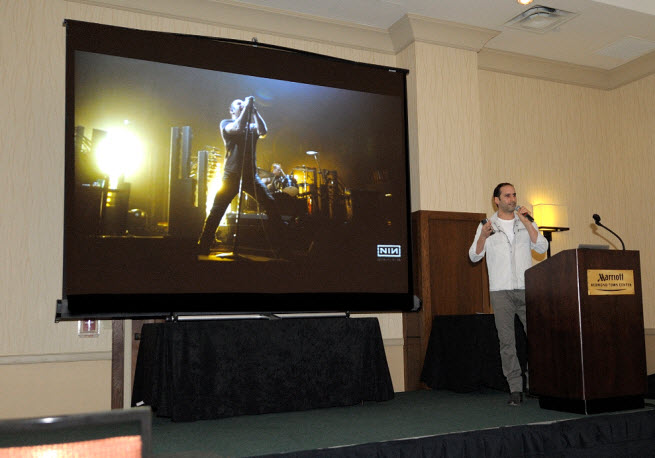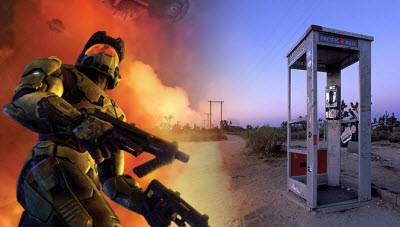Disclaimer: The organizers of Power of Play paid my way to Seattle, where I moderated a talk. Our coverage remains objective.
Elan Lee wants to remake entertainment by blending the interactivity of games and the passive viewing experience of TV. And he’ll get that chance by creating new interactive shows on Microsoft’s Xbox Live online entertainment platform on the Xbox One video game console.
If his past work is any guide, Xbox One consumers are in for one heck of a ride. Lee has been part of teams that have been doing some mind-bending work on alternate-reality games for the better more than a decade.
He was part of the team at 42 Entertainment that created the ilovebees.com campaign, which used tricks like making 50,000 pay phones ring at the same time (in the real world) to engage fans and warn them about the coming invasion of Earth at the beginning of the Halo 2 video game. At eDoc Laundry, his team embedded codes in T-shirts that could unlock episodes of web-based video mystery. And at Fourth Wall Studios, he created cool marketing campaigns like embedding the Sadie’s Story secret journey inside the Halo 3: ODST video game and made an alternate-reality game for the release of the Nine Inch Nails album Year Zero.
Lee is the new creative director at Microsoft’s Xbox Entertainment Studios in Los Angeles. He returned to Microsoft last year and reports to former CBS executive Nancy Tellem. We caught up with him at the Power of Play event in Seattle, where he gave a keynote speech.
GamesBeat: You gave a talk about the interesting combination of TV and games on the Xbox One platform. What were some of your broader thoughts on how to approach that?
Elan Lee: The basic problem before us, or the job description as I see it, is that Microsoft is going to build an interactive TV studio. We’re in the process of building that. It’s exciting, because right now, all these people have incredible hardware plugged into their televisions. They have controllers in their hands. They have synchronization software for their phones. They have gesture and voice recognition, all this stuff that makes you feel like you’re part of a deeper narrative. All of this was developed for video games, which are all about deeper narrative.
The next big challenge is, how do you apply that same mentality, that same suite of hardware, and those same learnings to television, and make television more immersive? How do you make the narratives more compelling? If you want to live in the same world as the characters you love, let’s enable that.
GamesBeat: What do you think about some of the interactive TV shows that have been tried before? What has been shown to work or not work?
Lee: The biggest thing that’s been tried before that I think has no future is this notion of choose-your-own-adventure. When we were kids, we all read those books. We all talked about them. But today, when you think about your favorite TV shows, your favorite characters, they go through this unbelievable conflict and at the end they come out victorious. Or, in the version you watched, I guess they didn’t come out victorious? Suddenly there’s ambiguity about how that story ended.
For me, personally, that’s a terrible experience. I want to be in the hands of a master storyteller. I want them to tell me the saga of this character that I get to live with across three seasons, who I care about deeply. I want to know the answer to the story. I don’t want one of 10 endings. If every ending is equally valid, suddenly none of them are important. That’s a real problem.
GamesBeat: Some of the fan reaction to the endings of big video games recently has generated an enormous amount of buzz or discussion. It seems that maybe the debate isn’t settled yet. BioShock Infinite, The Last of Us, Mass Effect 3 — all of these had very controversial endings. It seemed like a lot of people wanted to change the endings to suit their own preferences.
Lee: It’s an important point. There’s a fundamental difference between playing a game and watching TV. A game is your story. You talk about a game like you are the character. You’re taking over their body and controlling them and moving them through a narrative. I would argue that it’s okay for my story to be different from your story, even though we played the same game. That’s compelling. It’s something we can talk about. Each of us chose different paths because this is my story and that’s your story. It’s better if they’re not the same.
TV, I would argue, is in a different category. TV is third-person. TV is his story or her story. You sit back and get this god’s eye view of that story. If, suddenly, that story has multiple endings, it’s not his story anymore. It’s his story version one, or his story alternate version two. It’s not nearly as good a story that way, not as much of a narrative I care about.
GamesBeat: Given your past endeavors, like 42 Entertainment, what have you learned that you think is going to be something you’ll pull forward into this new way of doing TV?
Lee: A big thing I’ve learned is, figure out how to make your audience feel powerful because of the things they’re already good at. In this endeavor right now, that becomes very important.
Television is not broken right now. Television is better than it’s ever been. We have better stories. We’re figuring out delivery mechanisms. It’s amazing. So to come in and say, “Let’s fix television!” is a terrifying prospect. We don’t want to fix something that’s not broken.
So I’ve learned to respect the audience for what they’re already good at. They’re good at being passive. They’re good at experiencing TV shows that way. Let’s not fix that part. Instead, let’s learn from my knowledge of video games, my knowledge of viral marketing, my knowledge of building these compelling interactive narratives and deep immersion narratives, and say, “Listen. Audiences are going to sit back and watch a story. That’s awesome. If they choose, if they opt in to poke at the story and dig deeper, then let’s make a story that pokes back. If they want more narrative, let’s give them more, but if they don’t ever care to look, let’s not make them feel bad about that. Let’s make them feel amazing about that.” They get rewarded, through the narrative, for being exactly who they are and feeling like an extraordinary version of themselves, no matter what action they take.
Lee: Those experiments are amazing. I look at all of them, both the successes and the failures, because there’s so much to learn. If you imagine a spectrum, on the left is video games, and on the right is television. Left, completely active. Right, completely passive. What we’re experimenting with now is, we know there’s this craving for something in the middle.
We know we want our video games to be more like TV, because those narratives are so compelling. We know we want our TV to be more like video games, because we want to feel more empowered over the story. We want to be able to poke at it and get more out of it. But if you look at that spectrum, all of the different experiments you can place on that scale somewhere.
I believe the future is not in the middle. It’s much closer to the TV side. It’s not pegged out on the passive end, but it’s a few steps to the left of TV. It’s mostly passive, with a few interactive components that are a really easy ramp into the experience, a really low barrier to entry. Again, don’t break TV. Suggest enhancements that are optional if you want them.
GamesBeat: You have this platform with nearly 50 million Xbox Live members. What is it about the Xbox platform or the Xbox One in particular gives you the base that you need to work with?
Lee: The Xbox One is particular is so connected. It’s connected to your living room with gesture and voice recognition. Smartglass will connect to any smart device you throw at it. Suddenly you can start to play around with what it means to have an interactive story.
Let’s say you’re watching Game of Thrones and there’s an archer on the screen. He’s on top of a castle tower looking out across a valley and he sights the enemy coming across the field on horseback. He takes a bow and arrow and pulls back the arrow and lets fly. You see it fly across the TV screen, across the valley, across your living room, and on to your phone, where it lands with a thud as the thing shudders in your hand.
That’s a device. That’s an ecosystem of devices, aware of its environment and aware of how to use those systems to make storytelling more immersive. That’s an arrow that was just shot into your hand. How cool is that? How can we use elements like that for deeper and more engrossing storytelling? I’m not saying we’re going to do exactly that. But being aware of what these things are capable of makes for a whole new generation of stories that the Xbox can tell.
 GamesBeat: You’re doing this in Hollywood. How does that help you?
GamesBeat: You’re doing this in Hollywood. How does that help you?
Lee: It’s important that Microsoft decided to open the studio in Hollywood, instead of in Redmond. We have to be where the talent is. Microsoft needs to be able to partner up with the best storytellers in the world. All of this technology, all of this hardware, all of these networks, they completely fail if the story isn’t good. Story is absolutely the most important thing.
We have to live in the same town as those triple-A storytellers. We have to couple our technology prowess with their storytelling talents to create the future of living-room entertainment.
GamesBeat: What kind of interaction do you have across these different disciplines — the people in Redmond making games, the people in L.A. making film?
Lee: Microsoft has a number of studios spread out across the world. There’s obviously a huge technology base in Redmond. There’s the interactive sports team up in Vancouver. Additional device teams are all over the bay area. Then there’s us, the TV studio in L.A.
One of my big jobs, I’m on a plane every week at this point, traveling to these various studios to make sure we get the best of all those worlds. We’re all working together closely. Everyone’s aware of what everyone else is doing. We can use the power of Microsoft and this investment that we’ve already made to tell the best stories possible.
VentureBeat's mission is to be a digital town square for technical decision-makers to gain knowledge about transformative enterprise technology and transact. Learn More




